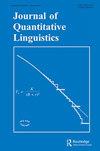17-19世纪德语文本中的词长分布
IF 1.7
2区 文学
0 LANGUAGE & LINGUISTICS
引用次数: 5
摘要
摘要德语文本中的单词长度一直是数量语言学领域中经常讨论的问题。然而,从现有的研究数据来看,大多数研究都集中在文学文本和私人信件上,每项研究的数据语料库规模相对较小。本文利用源自17世纪至19世纪的360篇文本,对德语中的单词长度分布进行了基于时间和体裁的分析,旨在从历时的角度找到一个能够很好地捕捉德语单词长度分布的概率分布,并揭示单词长度分布与文本类型和创作时间等边界条件之间的关系。结果表明,不同时代德语文本中的字长分布遵循1维超泊松分布,其参数(a,b)与边界条件相互关联。本研究证实,由于认知机制的限制,某一语言的单词长度分布是一致的。此外,概率分布参数可以很好地指示写作风格以及文本的创作时间。本文章由计算机程序翻译,如有差异,请以英文原文为准。
Word Length Distribution in German Texts during the 17th-19th Century
ABSTRACT Word length in German texts has been a frequently discussed issue in the field of quantitative linguistics. Taking an overall view of the existing research data, however, most of the research focuses on literary texts and private letters and the size of data corpus for each research is relatively small. This paper provides a time- and genre-based analysis of word length distribution in German using 360 texts originated between the 17th and 19th centuries, aiming to find a probability distribution that can capture well the German word length distribution from a diachronic perspective and to reveal the relationship between the word length distribution and boundary conditions such as the genre and the creation time of text. Results indicate that the word length distribution in German texts written in different eras abides by the 1-displaced hyper-Poisson distribution, whose parameters (a, b) are interconnected with boundary conditions. This study corroborates that the word length distribution of a certain language is consistent, due to the constraint of the cognitive mechanism. Besides, the parameters of probability distribution can be good indicators of the writing style as well as the creation time of text.
求助全文
通过发布文献求助,成功后即可免费获取论文全文。
去求助
来源期刊

Journal of Quantitative Linguistics
Multiple-
CiteScore
2.90
自引率
7.10%
发文量
7
期刊介绍:
The Journal of Quantitative Linguistics is an international forum for the publication and discussion of research on the quantitative characteristics of language and text in an exact mathematical form. This approach, which is of growing interest, opens up important and exciting theoretical perspectives, as well as solutions for a wide range of practical problems such as machine learning or statistical parsing, by introducing into linguistics the methods and models of advanced scientific disciplines such as the natural sciences, economics, and psychology.
 求助内容:
求助内容: 应助结果提醒方式:
应助结果提醒方式:


